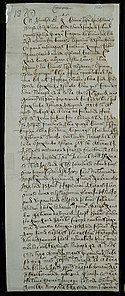Russian cursive
This article may be confusing or unclear to readers. (November 2018) |

Russian cursive is a variant of the Russian alphabet used for writing by hand. It is typically referred to as (ру́сский) рукопи́сный шрифт (rússky) rukopísny shrift, "(Russian) handwritten font". It is the handwritten form of the modern
History

The Russian (and Cyrillic in general) cursive was developed during the 18th century on the base of the earlier Cyrillic

The resulting cursive bears many similarities with the Latin cursive.[1] For example, the modern Russian cursive letter "п" may coincide with Latin cursive "n" (𝓃) (despite having completely different sound values); both upright and italic printed typefaces demonstrate less similarity.
One must not confuse the historical Russian chancery hand (ско́ропись, skóropis' ), the contemporary Russian cursive (рукопи́сное письмо́, rukopísnoe pis'mó) and the contemporary Russian
Features
Russian cursive is much like contemporary English and other Latin cursives. But unlike Latin handwriting, which can range from fully cursive to heavily resembling the printed typefaces and where idiosyncratic mixed systems are most common, it is standard practice to write in Russian cursive almost exclusively.
Ambiguities
There exists some ambiguity from the fact that several lowercase cursive letters consist (entirely or in part) of the element that is identical to the dotless Latin cursive letter
Some words in Russian may pose a challenge due to the similarities between the letters Ш, Щ, И, Л, М in cursive.


Variants, use of diacritics
In some forms of cursive, the distinction between
The letter д may also be written in the shape of
Differences to Serbian and Macedonian cursives
Several letters in Russian cursive are different from the cursive used in the
Charts
-
Modern Russian cursive
-
Varieties of Russian calligraphic cursive from an 1835 dictionary
-
Pre-reform Russian calligraphic cursive from a 1916 schoolbook
See also
- Cursive
- Russian alphabet
- Skoropis′
References
- ^ Белоконь, Е. А. (2001). Характеристика почерков XVIII-XIX вв. и термины в описаниях собраний рукописей [Characteristic handwriting XVIII-XIX centuries. and terms in descriptions of manuscript collections]. Вспомогательные исторические дисциплины: специальные функции и гуманитарные перспективы ; тезисы докладов и сообщений XIII научной конференции [Auxiliary Historical Disciplines: Special Functions and Humanitarian Perspectives; Abstracts of Reports and Communications of the XIII Scientific Conference] (in Russian). Moscow.
Термины «скоропись» и «курсив» в русской палеографии применяются параллельно, в то же время, в развитии русской скорописи намечаются тенденции, позволяющие выделить новый тип письма, схожий с латинским курсивным письмом, близким к современному. Если в частной сфере применения и в каллиграфии быстрее произошел переход к использованию курсивного письма, то в делопроизводственной традиции эти типы письма довольно долго сосуществовали.
≈ "Terms 'tachygraphy' and 'cursive' coexist in the Russian palaeography; meanwhile, in the development of the Russian tachygraphy there are tendencies that allow us to separate a new type of writing, one closer to the Latin cursive similar to its modern form. In the private sphere and in calligraphy, transition to the cursive writing occurred faster, but in the tradition of record keeping, these types of writing coexisted for a long time.{{cite book}}: CS1 maint: location missing publisher (link) - ISBN 86-363-0296-X.
- ISBN 978-608-220-042-2.
- ^ Serbian Cyrillic Letters BE, GHE, DE, PE, TE Archived 2008-08-21 at the Wayback Machine




